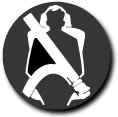|
Seat belts are designed to restrain adults safely in car
accidents, yet children must use these same belts as soon
as they are too old to ride in a car seat. Seat belts may
concentrate substantial forces on children's abdomens and
spines because of their shorter stature, creating "lap-belt
syndrome." Some parents, concerned about this syndrome, don't
buckle up their children; others don't out of sheer neglect.
To determine if children are safer wearing or not wearing
seat belts, the authors of a study in the British Medical
Journal looked at data on 470 children, ages 4-14 years,
and nearly three times as many adults involved in car accidents
in Canada. Only fatalities and injuries rated at least "moderately
severe" were considered.
A frightening 40% of the children involved in car accidents
were not wearing seat belts. Even when their parents were
belted, 22% of the children were still not buckled up. Children
riding in the front seat were almost 10 times more likely
to be injured or killed if not wearing seat belts; in the
back seat, their odds for injury were more than doubled if
not buckled up. Adults also fared better wearing seat belts.
They were more than twice as likely to  be
injured without a belt on, no matter where they were sitting
in the vehicle. be
injured without a belt on, no matter where they were sitting
in the vehicle.
There is no debate: Adults and children should always wear
seat belts. Despite the possibility of seat belts injuring
a vehicle's occupant, the risk for injury and death is always
higher if not wearing one. Be sure you and your kids are buckled
up before you start to drive, and keep children in car seats
until they are old enough to safely ride without them.
For more information about child passenger safety, visit
http://www.nhtsa.dot.gov/people/injury/childps.
Reference:
Halman SI, Chipman M, Parkin PC, et al. Are seat belt restraints
as effective in school age children as in adults? A prospective
crash study. British Medical Journal 2002:324, pp.
1123-1126.
For more studies on pediatric health, check out https://www.chiroweb.com/find/archives/pediatrics.
|



